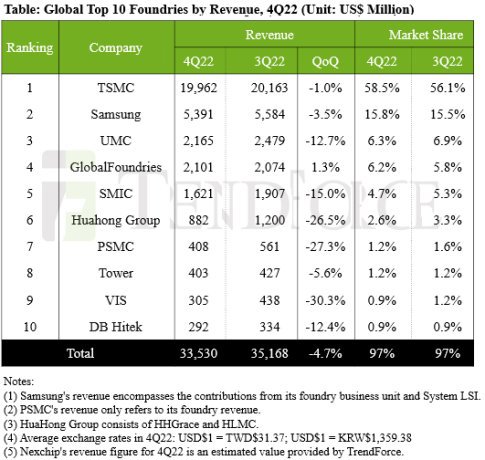Revising procurement quantities of long-term foundry contracts takes time and consequently only some tier-2 and -3 foundries were able to respond to the changes in their clients’ demand. Also, among them, 8-inch wafer foundries made a more pronounced reduction in their capacity utilisation rates.
As for the remaining foundries, the downward corrections that they made to their capacity utilisation rates did not become noticeable until 4Q22, so in 4Q22, the quarterly total revenue of the global top 10 foundries registered a QoQ decline for the first time after 13 consecutive quarters of positive growth.
The quarterly total revenue of the top 10 foundries came to $33.5 bn, reflecting a drop of 4.7% from 3Q22. Moving into 1Q23, TrendForce projects that the quarterly total revenue of the top 10 will show an even steeper drop on account of seasonality and the uncertain macroeconomic situation.
In 4Q22, foundries’ revenues were affected by an underwhelming peak season and their customers’ inventory corrections. Even with stock-up activities related to new iPhones and Android smartphones, TSMC still posted a QoQ drop of 1.0% in revenue to $19.9bn. However, TSMC’s revenue market share climbed to almost 60% mainly because tier-2 and -3 foundries took a heavier hit with respect to customers’ inventory corrections. Competitors’ weaker performances allowed TSMC to gain market share.
Regarding the revenues from TSMC’s process technologies, the decline in the revenues from the 7/6nm nodes was mostly offset by the rise in the revenues from the 5/4nm nodes. The share of the ≤7nm nodes in TSMC’s overall revenue remained stable at 54%.
Samsung experienced a drop in orders for advanced processes and a general demand contraction as its customers were concentrating on inventory reduction.
However, the demand drop associated with these factors was marginally offset by stock-up activities related to the components for the new iPhones and Android smartphones. All in all, Samsung posted a QoQ drop of 3.5% in foundry revenue to reach $5.5bn for 4Q22.
According to TrendForce, Samsung has lost a significant amount of demand for its ≤7nm nodes as Qualcomm and NVIDIA made the decision to reallocate orders for chips used in flagship hardware products. Currently, there are no new major customers that can effectively address the idling production capacity caused by the order reallocation. Therefore, the utilisation rates of Samsung’s advanced processes are projected to remain at a low level of around 60% through 2023.
UMC saw a drop in both capacity utilisation rate and wafer shipments in 4Q22, so its revenue fell by 12.7% QoQ to $2.2bn. In the aspect of wafer size and process technology, UMC saw a QoQ revenue decline for both 12- and 8-inch wafer foundry services, and its 0.35/0.25μm nodes had the worse revenue performance with a QoQ decline coming to 47%.
Conversely, in the case of GlobalFoundries, its revenue actually rose by 1.3% QoQ to $2.1bn thanks to the optimisation in its ASP and product mixes, as well as an increase in revenue from its non-wafer business.
GlobalFoundries was the only one among the top 10 to record a positive QoQ growth, and its revenue market share also climbed to 6.2%.

SMIC also saw a drop in both wafer shipments and wafer ASP. As a result, its revenue slid by 15.0% QoQ to $1.6bn. Looking at SMIC’s revenue by application or production category, the sharpest drops were experienced by chips related to smart home and consumer electronics.
The impact from order cuts varied for individual foundries in 4Q22, according to Trendforce, and there were two notable changes in the quarterly revenue ranking from sixth to 10th place.
First, Nexchip fell out of the top 10 group and will unlikely return in the short term. DB Hitek filled in the 10th place vacated by Nexchip in 4Q22.
Tower, which was in ninth place in the 3Q22 ranking, benefited from the stable demand for chips based on specialty process technologies and a relatively steady flow of orders from European clients during 4Q22. Tower posted a marginal QoQ decline of 5.6% in revenue to reach $403 million, and this result enabled it to surpass VIS to take eighth place in the 4Q22 ranking. Conversely, VIS was impacted by the downturn of the display panel industry and the slumping demand for consumer electronics in 4Q22. With a QoQ decline of around 30% in wafer shipments, VIS also recorded a QoQ drop of 30.3% in revenue to reach $305 million. Because of this performance, VIS slipped to ninth place in the ranking.













